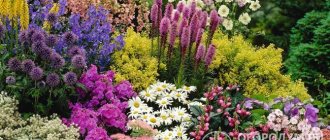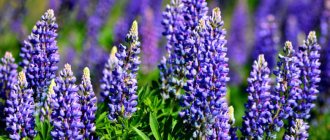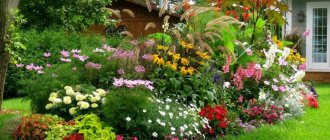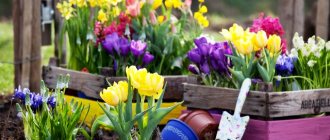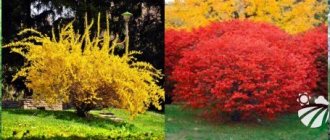Hanging plants are ornamental plants that have a long flexible stem and look beautiful in hanging pots. The stem of ampelous plants, as a rule, is not able to support itself; it needs to either rest on something or hang down. It is this property that makes hanging plants for the garden very popular among amateur gardeners. Such ornamental crops are mostly annuals in our conditions; they grow quickly, bloom almost all summer, and in a short period of time can transform the area adjacent to the house and individual corners of the garden into places of amazing beauty, inviting to relax among the splendor of the colors of nature.
The garden around the house was created using hanging plants - they are placed around the perimeter, suspended on the veranda. Their luxurious flowering can completely change the appearance of the site
Kinds
Ampelous plants for the garden, which can be planted in hanging pots, surprise with their diversity. The most common of them are:
- Petunia is the queen of ampelous flowers. Besides warmth and sun, she doesn’t really need anything else. Although an annual, it is very loved by gardeners;
- ampelous fuchsia is very spectacular, its flowers are small but bright;
- Surfinia is often called petunia; its flowers are similar, but smaller. Shoots can reach up to 1 m;
- Begonia is a shade-tolerant flower that does not tolerate sun and heat. It looks very beautiful in a flower pot, the greenery is at the top of the pot, and the inflorescences are cascading down;
Barrel with petunia
- ampelous geraniums are planted with several bushes of different colors in one pot. Multi-colored hats with long shoots delight the eye all summer;
- nasturtium is bright and colorful. The climbing type is suitable for hanging pots; upright bushes can decorate a flowerpot;
- Dichondra is called a silver waterfall due to the beautiful tint of its green leaves. The plant practically does not bloom, its advantage lies in its beautiful greenery, hanging down one and a half meters;
- lobelia is a bright bush with densely dotted small leaves and flowers. It is often planted only for the season, although it is perennial.
Forms of vertical gardening
Let's start with what has already become firmly established among domestic flower growers. Everywhere - in cities and in summer cottages - you can see hanging baskets with hanging flowers. In recent years, they have become as much a hallmark of the average country house design as the green lawns in front of the house.
Scaevola
Traditional hanging baskets are made from plastic-coated wire. The inside of the basket is lined with a special material made from coconut fibers, wool or waste from wood processing. All these materials hold the soil well and do not allow moisture to pass through. Slots are made on the side and plants are planted there, which form a spectacular flowering ball.
If you don’t have special material at hand, you can line the flower basket with a layer of sphagnum moss. This litter looks very natural. Solid baskets made of wicker branches are often used, but it is difficult to plant plants in them on the side.
Ampelous plants
The main problem with hanging flower beds is the rapid drying of the soil. Therefore, only drought-resistant plants can be planted in them, for example, ivy-leaved pelargonium, ampelous varieties of petunias, verbena, as well as a number of new ampelous plants that have appeared on sale recently. It is useful to add special granules that can accumulate moisture to the soil with which you fill the container. Thanks to this, plants planted in the basket will suffer less from drying out soil.
If today you won’t surprise anyone with a hanging basket, then a vertical flowerbed or flower tower can still be considered a relatively new word in domestic floriculture.
Ampelous plants
a vertical flower bed yourself. Take 4 pegs and drive them into the ground. Then connect the plastic coarse mesh with black lutrasil and secure it to the pegs. The resulting container is filled with earth, and two tubes are inserted inside for watering the plants. Seedlings are planted on the side in lutrasil cuts. It can be not only flowers, but also strawberries, herbs, and ornamental vegetables. Although you have to tinker, you won’t be ashamed to show off the result to your neighbors.
And finally, the latest in floral fashion is the so-called flower tower . It consists of a plastic bag with a diameter of 20-30 cm, which ends with a bowl at one end and a hanging hook at the other. The bag is filled with soil, and holes are cut in the walls for planting flowers. This flower structure is watered through a container located at the base of the flower tower.
Classification
Flowering shrubs for the garden, perennial and unpretentious
Plants are divided into several types and have their own characteristics:
- depending on preferences for light, there are light-loving and shade-loving;
- blooming ones love sun, warmth and regular watering. Most of them are annual. Those flowers that grow all year round require additional lighting;
- deciduous ones can do well in the shade. They may require high-quality soil to maintain bright leaf color, succulent stripes or spots;
- succulents require conditions close to the desert: the soil must be well-permeable, absorb moisture, the air must be dry, and there must be plenty of lighting.
Calibrachoa
The plant is surprisingly similar to petunia and for a long time was considered its subspecies, but biologists have found a fundamental difference both in the genomes of these crops and in the conditions of their maintenance. Calibrachoa also loves bright sun, but needs strictly dosed watering, since its root system quickly rots due to waterlogging. In order for the flower to live up to its name (“Million Bells”), it must be trimmed regularly during the growing season.
Benefits of Plants
What are ampelous plants and ampelous annual flowers?
The mobility of the plant is one of its main advantages. Even during one season, the location of the pot can be changed: to cover some unfinished areas in the garden, to hide areas of construction and repairs during the celebration. Plants do not require special care; they do not need to be weeded or to fight weeds and open ground pests.
For your information! If the plot of land in the garden is small, but you want a flower bed, unpretentious hanging flowers for the garden are an excellent solution.
Flowerbed design option
Bacopa
The South African heat-loving crop, otherwise called sutera, grows well in outdoor pots if planted in fertile, slightly acidic soil and watered regularly. Small flowers literally dot the lush bush, which looks chic thanks in part to the pretty leaves. The colors of bacopa are varied, but snow-white varieties are most common. Sutera seedlings are taken outside in the second half of May, when the threat of sudden night frosts has passed, and there the plant charms passersby until the beginning of autumn.
Blooming for more than one year
Yellow daisies are perennial flowers
Ampelous perennials make life much easier for the gardener, since they do not need to be sown every year. It is enough to provide them with certain wintering conditions. These include:
- Scaevola pleasant overwinters in a humid room at a temperature not exceeding 10 °C;
- dichondra overwinters with additional lighting and rare watering;
- bacopa will not bloom in winter, but if watered moderately, it will overwinter comfortably;
- Campanula equifolia is an ampelous perennial that blooms all summer. Tolerates winter together with indoor plants. Popularly called “bride and groom”;
- perennial lobelia will overwinter if it is covered and not allowed to get too cold;
- geranium can also overwinter in an apartment; with moderate watering and light, it blooms in winter.
Healing properties
Due to the fact that the plant contains substances such as anemone, vitamin C, tannin, organic acids, saponin, alkaloids, anemone has a wide range of medicinal properties:
- Antifungal - destroys various fungal formations.
- Painkiller - reduces the pain threshold for painful sensations.
- Expectorant - quickly removes mucus, while reducing its viscosity.
- Bactericidal - capable of neutralizing pathogens of any infectious diseases.
- Diaphoretic - helps remove salts and toxins from the body.
What to plant and how to choose hanging plants for your garden
Before planting garden hanging flowers, you need to take into account their preferences for light, soil, and watering. If you want to combine different species, you should plant those flowers with each other that require the same care; to do this, you should study their descriptions.
Note! Plants that are absolutely unpretentious to shade and sun are petunia, geranium, nasturtium, bidens. These flowers are resistant to direct sunlight, but can also grow in the shade.
It will be easier with hanging flower arrangements in the garden, since they can be moved if the plant begins to show its dissatisfaction with the excess or lack of sunlight.
Wall of hanging pots
Other names
The name of this plant in Latin is Anemone nemorosa, which means “daughter of the winds.” And in fact, even with the slightest breeze the plant begins to sway. Anemone has several other popular names:
- Freckles. This name was published in the book “Medicinal Herbs” by the Belarusian writer and public figure Zoska Veras.
- Kuroslep. It has this name because of its toxic effects.
- Drip. They are called because the leaves of the plant resemble hemp.
- Buttercup. They are named this way due to the fact that anemone, like all plants of the ranunculaceae family, contains anemonin.
- Snowdrop. These two types of plants have external similarities.
Compositions from ampelous plants
In open soil, you can create a picture with the help of ampelous outdoor plants. Suitable creeping plants that cover the soil include:
- Monkey loosestrife is a perennial plant that grows quickly as the weather warms up, covering the flower bed. The leaves are round, the flowers are small yellow, they can climb up and decorate the wall with their greenery;
- Lesser periwinkle is also a perennial, which in the spring will decorate its lush green shoots with purple flowers;
- dichondra will cover the carpet with long shoots and decorate the flowerbed.
Note! Old things that can be given a second life are suitable for decorating the garden as pots and flowerpots. These could be old carts, barrels, baskets, shoes.
For a dacha, hanging plants can decorate not only the site, but also braid a fence, a gazebo, and small structures (shower, cellar, outbuildings).
Even just placing pots along the path will become a decoration and will lift the spirits of both guests and owners
For your information! The more care and attention is invested at the beginning of a flower’s growth, the brighter and longer it will delight its gardener.
Contrasting combinations
For mixed compositions, you can combine different flowers, or you can plant the same type of different flowers. Pelargonium, petunia, nasturtium, fuchsia, and verbena will be excellent neighbors. They feel great in the company of other plant species. When creating a composition, you can play with:
- in color, choosing contrasts: white petunia and red pelargonium, blue lobelia and yellow begonia, fuchsia and white bacopa;
- in tiers. You can decorate the wall in tiers with colored balls. In such single pots, petunia, bacopa, lobelia, bidens will bloom in a spherical manner;
- shape and height. For example, dichondra, whose lashes will hang down, fits perfectly next to petunia. Fuchsia flowers fall down, and nasturtium may appear in the center.
Tiers in one pot
Almost all types of hanging plants are suitable for creating hanging gardens; the main thing is to remember that the smaller the pot, the more often the plant requires watering. Easy-to-care, hanging flowers for the garden will lift your spirits until the coldest weather.
Oak anemone in the Red Book
Today this plant is quite rare, is protected by the state, and in a number of areas it is listed in the Red Book. Let's mark these areas:
- Bryansk;
- Belgorodskaya;
- Vologda;
- Vladimirskaya;
- Moscow;
- Murmanskaya;
- Novgorodskaya;
- Orlovskaya;
- Smolenskaya;
- Tula;
- Yaroslavskaya.
In addition, the Stavropol Territory and Mari El should be noted.
In order to preserve this fragile crop, which has a lot of useful properties, it is first necessary to prohibit mass gatherings in places of natural growth, and its cultivation should also be increased.
Khosta
What are we all about flowers? There are, after all, crops that are valued for the beauty of their foliage and readily grow in the open air. Perennial shade-tolerant hostas, which came from China, are now familiar to any gardener - their rounded, lush bushes with lanceolate edged leaves are found on every second personal plot. You can grow any variety of this plant in outdoor pots, from the smallest to the giants. Hosta can bloom, throwing out long vertical peduncles with white or light purple buds, but this does not last long - one summer month.
Alyssum
The North American perennial from the cabbage family is famous for its hardiness - after all, in the wild it is a rock ground cover. The color range of alyssum, or simply alyssum, is varied: there are white, yellow, purple, lilac, pink and purple varieties. All of them are compact, 20-40 cm, and look great in outdoor flower pots and balcony greenhouses. Alyssum is actively used in landscape design, planted in mixborders, edgings, rock gardens and rockeries.
General care rules
By following a few care rules, you will create a comfortable living environment for your green pets.
- When planning to grow an ampelous plant in an apartment in a hanging pot, think about where you will mount it: to the ceiling or to the wall? Choose a strong mount, because it will need to support the plant, the container, and the weight of the pot after watering. Ceiling hooks attached with chains to pots have worked well.
- Most of this type of plant loves light, but grows poorly in dark places.
- It is more convenient to water with a watering can with an extended spout. This should be done regularly, but in moderation, to prevent the roots from rotting. If your flower grows in a decorative pot, pour out excess water after each watering.
- You need to spray hanging plants regularly, at any time of the year. The air at the top is drier than at the bottom, so don't skimp on water.
- Ampels that grow slowly do not need anti-aging pruning. Those plants whose shoots grow quickly, become elongated and lose their decorative appeal must be pruned regularly (zebrina, impatiens and pelargoniums).
- It is better to install the support either when the ampel has just begun to grow, or during transplantation, so as not to cause injury to the fragile root system. Bamboo is optimal in this case - it is well camouflaged in dense foliage, and it looks harmonious with the plant.
It is difficult to imagine a cozy home without indoor flowers. Currently, there are many varieties of them, each of which pleases with its sophistication, originality of colors, versatility of shapes and aromas. Therefore, you can always choose one or more plants, combining them by color, size and shape to create a beautiful composition.

